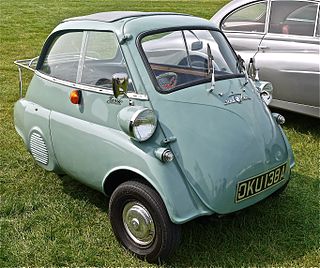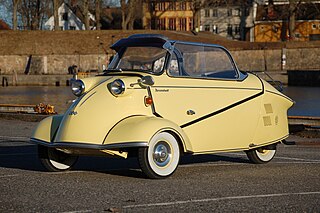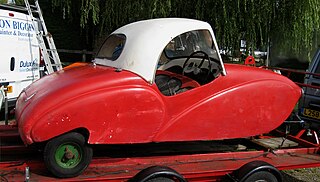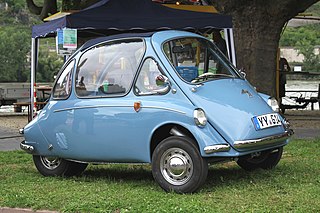
The Myers Motors NmG is a single-passenger, three-wheeled, battery electric vehicle designed specifically for commuting and city driving. It was initially produced by Corbin Motors and now by Myers Motors. It is a personal electric vehicle (PEV).

Zeta is a marque of automobile which was produced in Australia from 1963 to 1965 by South Australian manufacturing company Lightburn & Co.

The Isetta is an Italian-designed microcar built under license in a number of different countries, including Argentina, Spain, Belgium, France, Brazil, Germany, and the United Kingdom. Because of its egg shape and bubble-like windows, it became known as a bubble car, a name also given to other similar vehicles.

The Mazda Carol is a name that was used by Suzuki for Mazda for its kei cars from 1962 until 1970. It was revived again with Mazda's 1989 re-entry into the kei car class with the Autozam brand. Since then, it has been related to the Japanese Suzuki Alto.
Sharps Commercials Ltd was a British car maker based in Preston, Lancashire. It was founded in 1922 by Paul Sharp. It changed its name to Bond Cars Ltd in 1963. The company was taken over by the Reliant Motor Co Ltd of Tamworth, Staffordshire in February 1969, who eventually closed the Preston factory in August 1970, transferring the spare parts business for the Bond Minicar, 875 saloon, 875 Ranger van and Equipe models to a firm called Bob Joyner & Son in Oldbury in the English Midlands. Reliant nevertheless continued to use the Bond name until 1974 on Bond Bug models made at their own Tamworth plant.

The Daihatsu Bee is a three-wheeled microcar produced by the Japanese manufacturer Daihatsu from 1951 until 1952.

The Messerschmitt KR200, or Kabinenroller, was a three-wheeled bubble car designed by the aircraft engineer Fritz Fend and produced in the factory of the German aircraft manufacturer Messerschmitt from 1955 to 1964.

The Messerschmitt Kabinenroller was a series of microcars made by Messerschmitt from 1953 to 1956 and by Fahrzeug- und Maschinenbau GmbH, Regensburg (FMR) from 1956 to 1964. All the Messerschmitt and FMR production cars used the Kabinenroller's monocoque structure, featuring tandem seating and usually a bubble canopy.

The Messerschmitt KR175 microcar (1953–1955) was the first vehicle built by Messerschmitt under its 1952 agreement with Fritz Fend. In concept, although not in actual design, it was an extended version of the Fend Flitzer invalid carriage. Approximately 15,000 were built before it was replaced by the Messerschmitt KR200 in 1956.
Zoe Motors, Inc., a subsidiary of Zoe Products Inc., was an early-1980s automotive company based in California and best known for its Zoe Zipper three-wheeled microcar. Zoe was publicly traded on the NASDAQ as ZOEP and later ZOEP.PK, although the company is no longer active today. In addition to the Zipper, Zoe's products included the Little Giant truck and the Zoe Runner.

The Subaru 1000 was the first front wheel drive Subaru produced by Fuji Heavy Industries that was in the Japanese government "compact car" classification starting in 1966. Previous Subaru models such as the Subaru 360 and the Sambar had been rear-engined, rear wheel drive kei cars.

The Tourette was a microcar by Carr Brothers of Purley, London, England between 1956 and 1958.

Suzulight was the brand used for the kei cars built by the Suzuki Motor Corporation from 1955 to 1969. They were Suzuki's first entry into automotive manufacturing, having previously only produced motorcycles. The Suzulight sedans and light vans all had transversely mounted engines and front-wheel drive. The Suzulight Carry trucks and vans were the first to use the Carry label, still around today.

Meadows Frisky is the name of a series of small British cars manufactured at the factory of Henry Meadows Ltd at Fallings Park in Wolverhampton between 1958 and 1961, during which time, production was under the control of a number of companies.

The AC Petite is a three-wheeled British microcar with a rear-mounted 350 cc (21 cu in) Villiers single cylinder, two-stroke engine. The car has a single bench seat seating two adults, and was said to be capable of 60 mpg‑imp to 70 mpg‑imp and 40 mph (64 km/h).

Allard, better known for light sports cars, produced a pilot run of around twenty fibreglass-bodied three-wheeled Clipper microcars in 1953–54. The rear-mounted Villiers 24B 346 cc (21.1 cu in) single-cylinder two-stroke motorcycle engine drives the rear left wheel via a Burman gearbox and chain.

Buckle Motors Pty Ltd is an Australian car dealership chain and former manufacturer that produced the famous Goggomobil Dart. Currently, under the name Bill Buckle Auto Group, the company sells Toyota, Subaru and Volkswagen vehicles.

The Suzuki CV1 is a microcar first presented at the 24th Tokyo Motor Show.

Electra Meccanica Vehicles Corporation is a Canadian manufacturer of an electrically-powered microcar. The company was established in 2015 in Vancouver, British Columbia by Henry Reisner of Intermeccanica and Jerry Kroll, a former race-car champion and the former CEO of CRAiLAR Technologies. Kroll was also an MLA candidate in 2017 for the Green Party. He has previously developed electric drive systems in race cars for five years at the NASA Research Park in Mountain View, California.




















